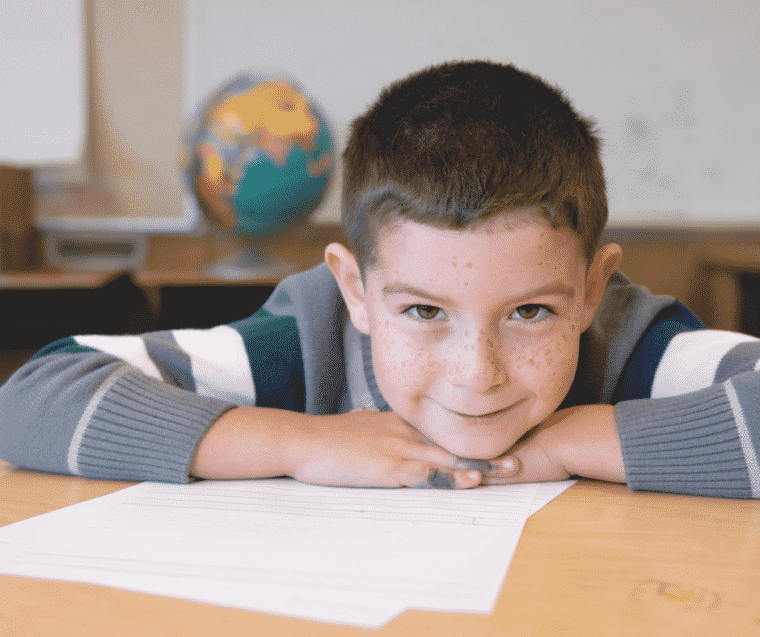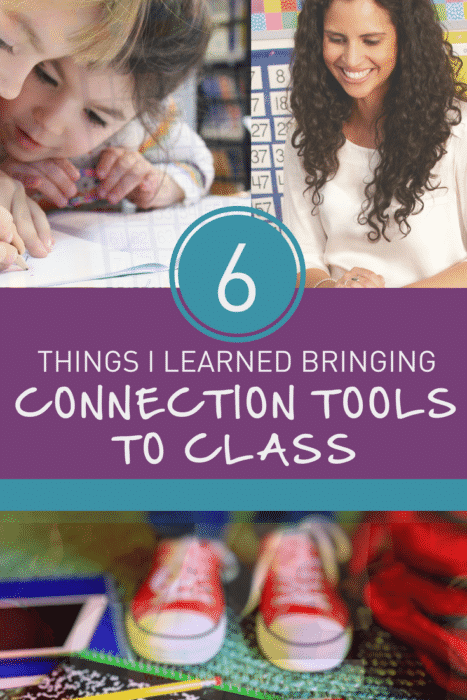Hand in Hand Parenting Instructor Sarah Charlton works as a learning support assistant with secondary school-aged children in the UK and has seen the benefits of bringing connection tools into the classroom, with teachers and pupils.
Here are six illuminating lessons she learned along the way.
6 Things I Learned When I Brought Connection into the Classroom
Limits can be set with warmth, even playfully in school.
One girl who is highly resistant to any kind of instruction responded beautifully when I adopted a more playful approach and ‘chased’ her back to her desk. Another challenging student was able to hear my limit to stop her purposefully annoying behavior when I got down on her level, made good eye contact and calmly and warmly repeated my request a few times for her to cease banging her pen on the desk.
Read more about setting warm, playful limits in school
Listening After a Limit Really Helps
 When off-track behavior occurs in the classroom taking a student outside and listening to them for a couple of minutes can be all that’s needed. By taking a calm and empathic interest in what is happening for them, listening to how the lesson is ‘boring’ or how the teacher is ‘picking on me’ can sometimes be enough for the child to return to the lesson feeling calmer and ready to pay attention again. This is so much more effective than punitive measures that stress both student and teacher.
When off-track behavior occurs in the classroom taking a student outside and listening to them for a couple of minutes can be all that’s needed. By taking a calm and empathic interest in what is happening for them, listening to how the lesson is ‘boring’ or how the teacher is ‘picking on me’ can sometimes be enough for the child to return to the lesson feeling calmer and ready to pay attention again. This is so much more effective than punitive measures that stress both student and teacher.
Of course, this is only possible when there is a second adult in the classroom, but if all classroom assistants were taught how to do this, it would have a school-wide impact.
Even Small Moments of Connection Make a Difference
There is a lovely sign above the entrance to our school library. It says “No act of kindness, no matter how small, is ever wasted.” Given how thirsty our children are for connection it’s good to see how even little boosts make a difference. A smiling hello using a child’s name lets a child feel seen in a crowded corridor. Taking a minute to stop and ask “How was your weekend,” or “How did that maths assignment go” help a student to feel cared for.
Just a Few Minutes Special Time Can Work Miracles in School
I work one-to-one with students struggling with anxiety and low self-esteem. The look of wonder on a child’s face when I tell them that for the next ten minutes they are in charge and I will do anything they like is priceless! (With the proviso that we don’t disrupt anyone else) One 11-year-old boy looked up at me beaming and said ‘I’ve never had this much power!’
I’ve played hide-and-seek in the corridors, had pillow fights and indoor ‘snowball’ fights with students. initiating laughter is a powerful and overlooked way to helping children relax and feel heard.
Find out more about Special Time
Helping Children Find Their Voices Can Bring Change
 In a system designed around standardisation and conformity, children’s voices don’t always get heard. Economic pressures and performance-linked pay can leave good, hardworking teachers feeling stressed and under-supported and children inevitably feel some of that burden. Pushing palm to palm when a child feels overburdened with work, or powerless in the face of bullying can work brilliantly to help a child find their voice. Ask them to push as hard as they like against your hands and offer some words to counteract the injustice they are feeling – “How dare you” or “I won’t let you push me around” or whatever words are appropriate can help to redress some power imbalance.
In a system designed around standardisation and conformity, children’s voices don’t always get heard. Economic pressures and performance-linked pay can leave good, hardworking teachers feeling stressed and under-supported and children inevitably feel some of that burden. Pushing palm to palm when a child feels overburdened with work, or powerless in the face of bullying can work brilliantly to help a child find their voice. Ask them to push as hard as they like against your hands and offer some words to counteract the injustice they are feeling – “How dare you” or “I won’t let you push me around” or whatever words are appropriate can help to redress some power imbalance.
Even when invitations to try this are met with rolling eyes or nervousness, with some gentle encouragement they soon get the hang of it and when laughter happens I know that tension is being released.
Accepting All Feelings Removes the Need to Fix or Find Solutions
Just deeply listening to a child without any agenda or thinking that I have to ‘fix’ them can powerfully help a child to heal and grow. Welcoming whatever they are feeling, be it boredom, hopelessness, anger or frustration with empathy and warmth, and shining the full beam of enthusiastic approval and confidence in a child’s goodness and capabilities, can be just what’s needed to boost their self-esteem and restore a child’s natural willingness to co-operate and enjoy life.
Start Small but Aim Big
Making any kind of change in a school is like trying to turn an ocean liner. It’s hard and takes a long time. Trusting relationships have to be built over long periods of time and there needs to be a willingness to fail and keep learning and adapting if progress is to be made. I did try once, after about six months, to introduce the idea of listening partnerships to staff, however, in view of what I have learned since I see that this was a premature offering. After almost three years I am probably better placed to try again. This time around I would start small and let it grow organically rather than make a whole school invitation.
Allies are invaluable and you must be willing to keep working on your own unresolved childhood experiences of school in order to maintain a relaxed hopeful attitude.
In such a demanding environment staff compete to be heard in order to offload the challenges of the day and with resources so tight in many schools, building in structured emotional support is a challenge for senior staff regardless of how much they value their staff teams.
Looking after yourself emotionally, physically and mentally is imperative but the feel-good factor of coming home knowing you’ve made a difference that day makes the perseverance so very worthwhile.
Take Connection Tools To School
Want to bring Hand in Hand to your school or practice? Get more information about Hand in Hand's 8-week Professionals Intensives.

